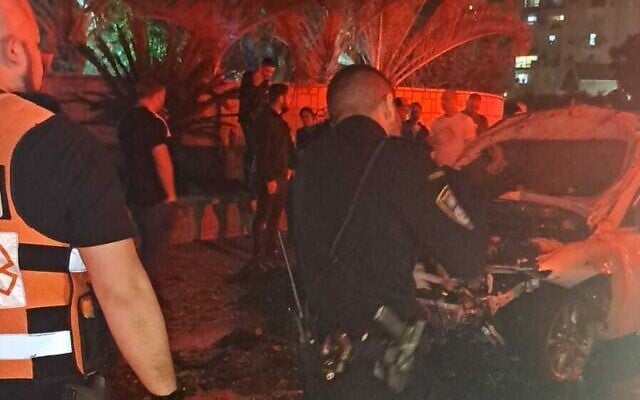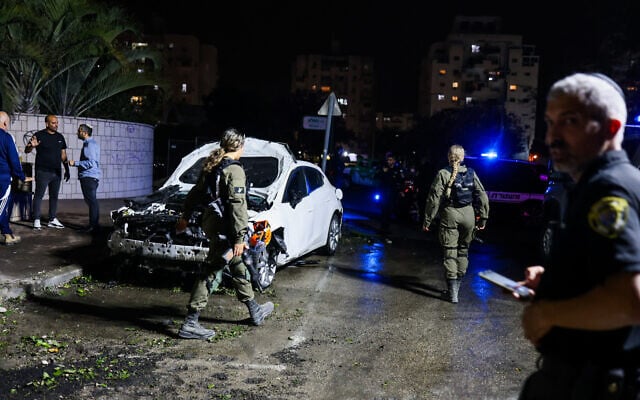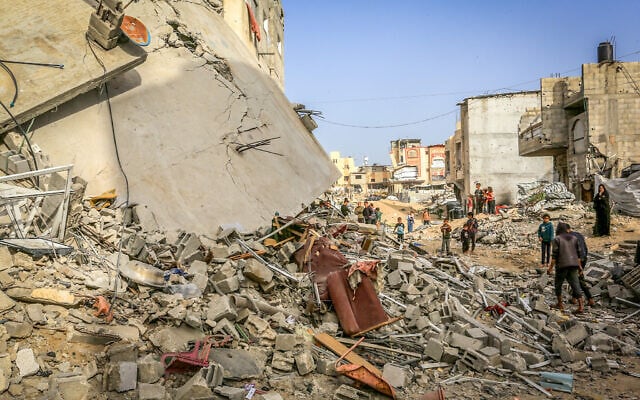



A 30-year-old man in Ashkelon was lightly wounded by shrapnel during a rocket barrage fired from Gaza at southern Israel on Sunday as Hamas launched the largest such attack it has carried out in months, prompting Israel to vow that the terror group would pay a heavy price.
Shortly after 9 p.m. on Sunday, 10 rockets were launched toward the coastal cities of Ashkelon and Ashdod in southern Israel, from central Gaza’s Deir al-Balah, marking the largest barrage from Gaza in many months.
Five of the ten rockets were intercepted by Israel’s air defenses, the Israel Defense Forces said, and at least one of the five that were not intercepted hit Ashkelon, causing damage and lightly injuring a 30-year-old man, who was taken to the coastal city’s Barzilai Hospital for treatment.
The Magen David Adom emergency services said that two other people were hurt while running to shelters, while several people were treated for acute anxiety following the attack.
Home Front Command officers were also operating at the sites of rocket impacts, the military said.
Footage posted to social media showed the moment of the impact in Ashkelon on Sunday, with the rocket appearing to strike near several high-rise apartment buildings.
Hamas claimed responsibility for the rocket fire shortly after it was launched.
Following the attack, the IDF’s Arabic-language spokesman, Col. Avichay Adraee, issued an evacuation warning for Palestinian civilians in the Deir al-Balah area, saying that it was a “final warning” before the IDF carried out strikes there.
The military then said that it had carried out a drone strike targeting the rocket launcher used to launch the barrage from central Gaza.
Prime Minister Benjamin Netanyahu, who was en route to Washington DC during the attack, called Defense Minister Israel Katz from his Wing of Zion plane.
According to his office, Netanyahu told Katz to respond harshly, approving the continuation of intensive military operations against Hamas in Gaza.
In a statement issued not long after his conversation with the premier, Katz said he had instructed the IDF to “continue and widen” the ongoing offensive against Hamas in the Gaza Strip.
He said he had told the military to “deal a very powerful blow to Hamas in Gaza in response to the [rocket] fire,” adding that “For every piece of shrapnel that hits a resident of Ashkelon, the Hamas murderers will pay a very heavy price.”
The salvo of rockets was the largest attack launched by Hamas since the collapse of the ceasefire and hostage deal last month.
The deal was intended to be a multi-phase agreement that would see the release of all hostages from Gaza, both living and dead, and bring a permanent end to the war there.
In total, Hamas released 30 hostages and returned the bodies of eight slain Israeli captives during the first phase of the ceasefire between January and March.
The second phase of the deal, had it taken place, was supposed to see the return of all remaining living hostages in exchange for the full withdrawal of Israeli force from Gaza and a permanent end to the war.
But while Netanyahu signed onto the deal, he has long rejected the latter two clauses of phase two, arguing they would allow Hamas to remain in power. Accordingly, he has largely refused to hold talks regarding phase two of the deal, which were supposed to begin on February 2.
As such, when the first phase came to an end, and Hamas refused to accept proposals to extend it, rather than moving to phase two, Israel cut off all aid deliveries to Gaza in early March, and resumed military operations throughout the Strip on March 18.
The enclave’s Hamas-run health ministry, which does not differentiate between civilians and combatants in its unverified figures, has said that more than 1,000 Palestinians have been killed so far in the renewed fighting.
On Sunday, health authorities in Gaza said that at least 32 people had been killed in strikes over the past day, including over a dozen women and children.
According to southern Gaza’s Nasser Hospital, strikes overnight between Saturday and Sunday hit a tent and a house in the city of Khan Younis, killing five men, five women, and five children.
In northern Gaza, the Hamas-run health ministry said that at least four people had been killed in the Jabalia refugee camp, and the Hamas-linked civil defense agency said that a strike in Gaza City had hit people waiting outside a bakery, killing at least six, including three children.
In the center of the Strip, an Associated Press journalist reported that the bodies of seven people arrived at the Al-Aqsa Martyrs Hospital in Deir al-Balah, including a child and three women.
The war in Gaza was sparked by the October 7, 2023, Hamas invasion and massacre in southern Israel, in which roughly 1,200 people, mostly civilians, were killed, and 251 were seized as hostages.
Fifty-nine of the 251 hostages remain in captivity, of whom 24 are still alive, according to Israeli intelligence assessments. Over 100 hostages were released during a weeklong truce in November 2023, and during the recent ceasefire, Hamas released 30 living hostages were — 20 Israeli civilians, five soldiers, and five Thai nationals — and the bodies of eight slain Israeli captives.
The Hamas-run Gaza health ministry says more than 50,000 people in the Strip have been killed or are presumed dead in the fighting so far, though the toll cannot be verified. Israel says it has killed some 20,000 combatants in battle as of January and another 1,600 terrorists inside Israel on October 7.
Israel has said it seeks to minimize civilian fatalities and stresses that Hamas uses Gaza’s civilians as human shields, fighting from civilian areas including homes, hospitals, schools, and mosques.
Israel’s toll in the 18-month-old ground offensive in the Strip and i military operations along the border stands at 410, including a police officer killed in a hostage rescue mission and two Defense Ministry civilian contractors.
Agencies contributed to this report.



